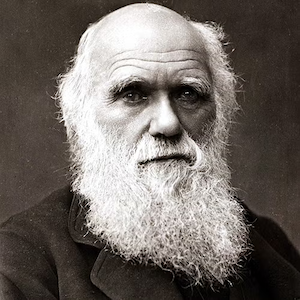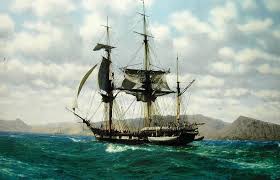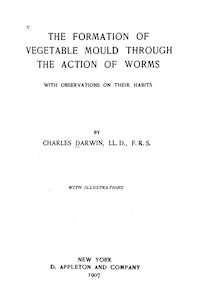Charles Darwin

Description
Charles Robert Darwin (1809-1882) was a British biologist and naturalist best known for his theory of evolution and the process of natural selection. [2] He transformed the way humans understand the natural world and was a true revolutionary. In current society, he is celebrated as one of the best and brightest British scientists who ever lived, but when he was alive his theories were deemed radical and created conflict between himself and the members of the Church of England.[3]
Early Life

Charles Darwin was born in Shrewsbury, Shropshire, England on February 12, 1809, seemingly already with his fascination of the natural world. As a child, he was an avid reader, specifically of nature books, and spent his spare time exploring and collecting plants and insects from the woodlands and fields around his childhood home. In 1825, at the age of 16, Darwin enrolled in medical school at the University of Edinburgh in Scotland. While in medical school, he witnessed surgery on a child, and upon watching this procedure, he gave up his studies. This is because surgeries at the time were carried out with no anesthetic or antiseptics, and fatalities were very common, so it was a very traumatizing experience to endure. Darwin was not just studying medicine in Edinburgh, he was also receiving lessons in taxidermy from a former enslaved man, John Edmonstone. This skill would prove to be crucial as he continued into his career.[3] Upon leaving Scotland, Darwin went to Christ's College, a constituent college of the University of Cambridge, to study theology at his father’s request, though after taking a biological science he felt inclined to study natural history. course[2]
HMS Beagle Voyage

While Darwin was receiving his bachelor’s degree, botany professor John Stevens Henslow became his mentor, and upon Darwin’s graduation his mentor recommended him for a naturalist position on the HMS Beagle. The ship was to take a five-year trip around the world so they may survey and study a variety of natural specimens. Through hands-on experimentation and research, Darwin had the unique opportunity to observe how the principles of botany, geology, and zoology relate to the real-world. The Pacific Islands, South America, and of course the Galapagos Archipelago were of special interest. After returning to England in 1836, Darwin began writing up his findings in a journal, that was later published as a part of the Beagle's captain’s larger narrative. The larger narrative was later edited into the “Zoology of the Voyage of the Beagle”. The 5-year voyage had a monumental effect on Darwin and his view of the natural world. He began to develop a theory on the origin of living things that was almost completely contrary to the popular view at the time. [2]
Theory of Evolution
Following his voyage on the ‘HMS Beagle,’ Darwin developed his theory of evolution, which declared that species survived through “natural selection.” Natural selection is the process in which those that have successfully adapted or evolved to fit the changing requirements of their habitat are the ones that survive and reproduce, meanwhile those that failed to adapt die off. His theory of evolution and the process of natural selection eventually became known as “Darwinism.” At the time, though, other naturalists believed that all species either came into being at the beginning of Earth or were simply created over the course of natural history. It wasn’t until the next century that DNA studies provided scientific evidence of Darwin’s theory of evolution, though there is still conflict regarding the topic today as Creationism (the religious view that all beings were created by God) is still prevalent in some areas. [2]
The Formation of Vegetable Mould Through the Action of Worms

Darwin’s last piece of published work before his death in 1882 was “The Formation of Vegetable Mould Through the Action of Worms”. Released in 1881, it was the first ever publication regarding earthworms and their importance. The book detailed Darwin’s extensive research on the importance of worms and their impact on soil formation. In his research, he learned that the worms pass through the earth, and they don’t just move it but help to create it as they travel through the soil. He also highlighted the impact they have on soil fertility, and in his conclusion, he writes that worms, “have played a more important job in the history on the world that most persons would at first suppose.”[6] Without this book, and without Charles Darwin, the study of soil and its inhabitants would not be as far along as it is today, and Soil Ecology may not have ever existed.
References
- ↑ Bob Thomas, Popperfoto via Getty Images, Getty Images
- ↑ 2.0 2.1 2.2 2.3 Charles Darwin - Theory, Book & Quotes. 2021, March 29. . https://www.biography.com/scientists/charles-darwin.
- ↑ 3.0 3.1 Charles Darwin, History’s most famous biologist, Natural History Museum. https://www.nhm.ac.uk/discover/charles-darwin-most-famous-biologist.html.
- ↑ Ellen Wallace Sharples, via University of Bristol
- ↑ HMS Beagle | Nautilus Historic Ships Archive. (n.d.). . https://www.nautilusint.org/en/news-insight/ships-of-the-past/2021/january/hms-beagle/.
- ↑ 6.0 6.1 Darwin, C. 1907. The Formation of Vegetable Mould Through the Action of Worms: With Observations on Their Habits. D. Appleton.